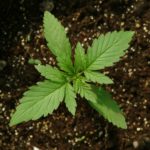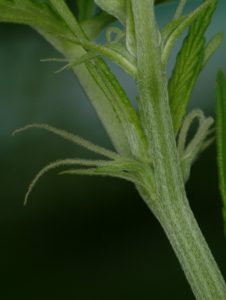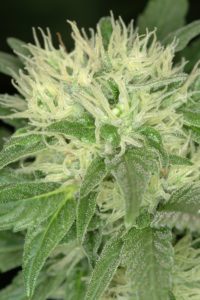Chapter one – Medical Grower’s Bible
Introduction
The key to successful indoor cannabis cultivation is to understand how cannabis produces food and grows. Cannabis, whether cultivated indoors or out, has the same requirements for growth. It needs light, air, water, nutrients, a growing medium, and heat to manufacture food and to grow. Without any one of these essentials, growth stops and death soon results. Indoors, the light must be of the proper spectrum and intensity; air must be warm, arid, and rich in carbon dioxide; water must be abundant but not excessive, and the growing medium must contain the proper levels of nutrients for vigorous growth. When all these needs are met consistently at optimum levels, optimum growth is the result.
Cannabis is normally grown as an annual plant, completing its life cycle within one year.
A seed that is planted in the spring will grow strong and tall through the summer and flower in the fall, producing more seeds. The annual cycle starts all over again when the new seeds sprout the following year. In nature, cannabis goes through distinct growth stages. The chart below delineates each stage of growth.
 Life Cycle of Cannabis
Life Cycle of Cannabis
After 3-7 days of germination, plants enter the seedling growth stage which lasts about a month. During the first growth stage the seed germinates or sprouts, establishes a root system, and grows a stem and a few leaves.
Germination
During germination moisture, heat, and air activate hormones (cytokinins, gibberellins, and auxins) within the durable outer coating of the seed. Cytokinins signal more cells to form and gibberellins to increase cell size. The embryo expands, nourished by a supply of stored food within the seed. Soon, the seed’s coating splits, a rootlet grows downward, and a sprout with seed leaves pushes upwards in search of light.
Seedling Growth
The single root from the seed grows down and branches out, similar to the way the stem branches up and out above ground. Tiny rootlets draw in water and nutrients (chemical substances needed for life). Roots also serve to anchor a plant in the growing medium. Seedling should receive 16-18 hours of light to maintain strong healthy growth.
 Vegetative Growth
Vegetative Growth
Vegetative growth is maintained by giving plants 16-24 hours of light every day. As the plant matures, the roots take on specialized functions. The center and old, mature portions contain a water transport system and may also store food. The tips of the roots produce elongating cells that continue to push farther and farther into the soil in search of more water and food. The single-celled root hairs are the parts of the root that actually absorb water and nutrients. Without water, frail root hairs will dry up and die. They are very delicate and are easily damaged by light, air, and klutzy hands if moved or exposed. Extreme care must be exercised during transplanting.
Like the roots, the stem grows through elongation, also producing new buds along the stem. The central or terminal bud carries growth upward; side or lateral buds turn into branches or leaves. The stem functions by transmitting water and nutrients from the delicate root hairs to the growing buds, leaves, and flowers. Sugars and starches manufactured in the leaves are distributed through the plant via the stem. This fluid flow takes place near the surface of the stem. If the stem is bound too tightly by string or other tie-downs, it will cut the flow of life-giving fluids, thereby strangling and killing the plant. The stem also supports the plant with stiff cellulose, located within the inner walls. Outdoors, rain and wind push a plant around, causing much stiff cellulose production to keep the plant supported upright. Indoors, with no natural wind or rain present, stiff cellulose production is minimal, so plants develop weak stems and may need to be staked up, especially during flowering.
Once the leaves expand, they start to manufacture food (carbohydrates). Chlorophyll (the substance that gives plants their green color) converts carbon dioxide (CO2) from the air, water, and light energy into carbohydrates and oxygen. This process is called photosynthesis. It requires water drawn up from the roots, through the stem, into the leaves where it encounters carbon dioxide. Tiny breathing pores called stomata are located on the underside of the leaf and funnel CO2 into contact with the water. In order for photosynthesis to occur, the leaf’s interior tissue must be kept moist. The stomata open and close to regulate the flow of moisture, preventing dehydration. Marijuana leaves are also protected from drying out by an outer skin. The stomata also permit the outflow of water vapor and waste oxygen. The stomata are very important to the plant’s well being and must be kept clean to promote vigorous growth. Dirty, clogged stomata would breathe about as well as you would with a sack over your head!
 Pre-Flowering
Pre-Flowering
Cannabis grown from seed dawns pre-flowers after the fourth week of vegetative growth. They generally appear between the fourth and sixth node from the bottom of the plant. Cannabis plants are normally either all male or all female. Each sex has its own distinct flowers. Pre-flowers will be either male or female. Growers remove and destroy the males (or use them for breeding stock) because they have low levels of cannabinoids (THC, CBD, CBN, etc.). Female plants are cultivated for their high cannabinoid content.
Mother Plants
Growers select strong, healthy, potent mother plants they know are female. Mothers are given 18-24 hours of light daily so they stay in the vegetative growth stage. Growers cut branch tips from the mother plants and root them. The rooted cuttings are called “clones.” Cultivating several strong, healthy mother plants is the key to having a consistent supply of all-female clones.
Cloning
Branch tips are cut and rooted to form clones. Clones take 10-20 days to grow a strong healthy root system. Clones are given 18-24 hours of light so they stay in the vegetative growth stage. Once the root system is established, clones are transplanted into larger containers. Now they are ready to grow for 1-4 weeks in the vegeta- tive growth stage before being induced to flower.
 Flowering
Flowering
Cannabis flowers outdoors in the fall when days become shorter and plants are signaled that the annual life cycle is coming to an end. At flowering, plant functions change. Leafy growth slows, and flowers start to form. Flowering is triggered in most commercial varieties of cannabis by 12 hours of darkness and 12 hours of light every 24 hours. Plants that developed in tropical regions often start flowering under more light and less darkness. Flowers form during the last stage of growth. Left unpollinated, female flowers develop without seeds, “sinsemilla.” When fertilized with male pollen, female flower buds develop seeds.
Unpollinated, female cannabis flowers continue to swell and produce more resin while waiting for male pollen to successfully complete their life cycle. After weeks of heavy flower and cannabinoid-laden resin production, THC production peaks out in the unfertilized, frustrated sinsemilla!
Cannabis has both male and female plants. When both male and female flowers are in bloom, pollen from the male flower lands on the female flower, thereby fertilizing it. The male dies after producing and shedding all his pollen. Seeds form and grow within the female flowers. As the seeds are maturing, the female plant slowly dies. The mature seeds then fall to the ground and germinate naturally or are collected for planting next spring.
JORGE CERVANTES
Published on Dolce Vita International 1




